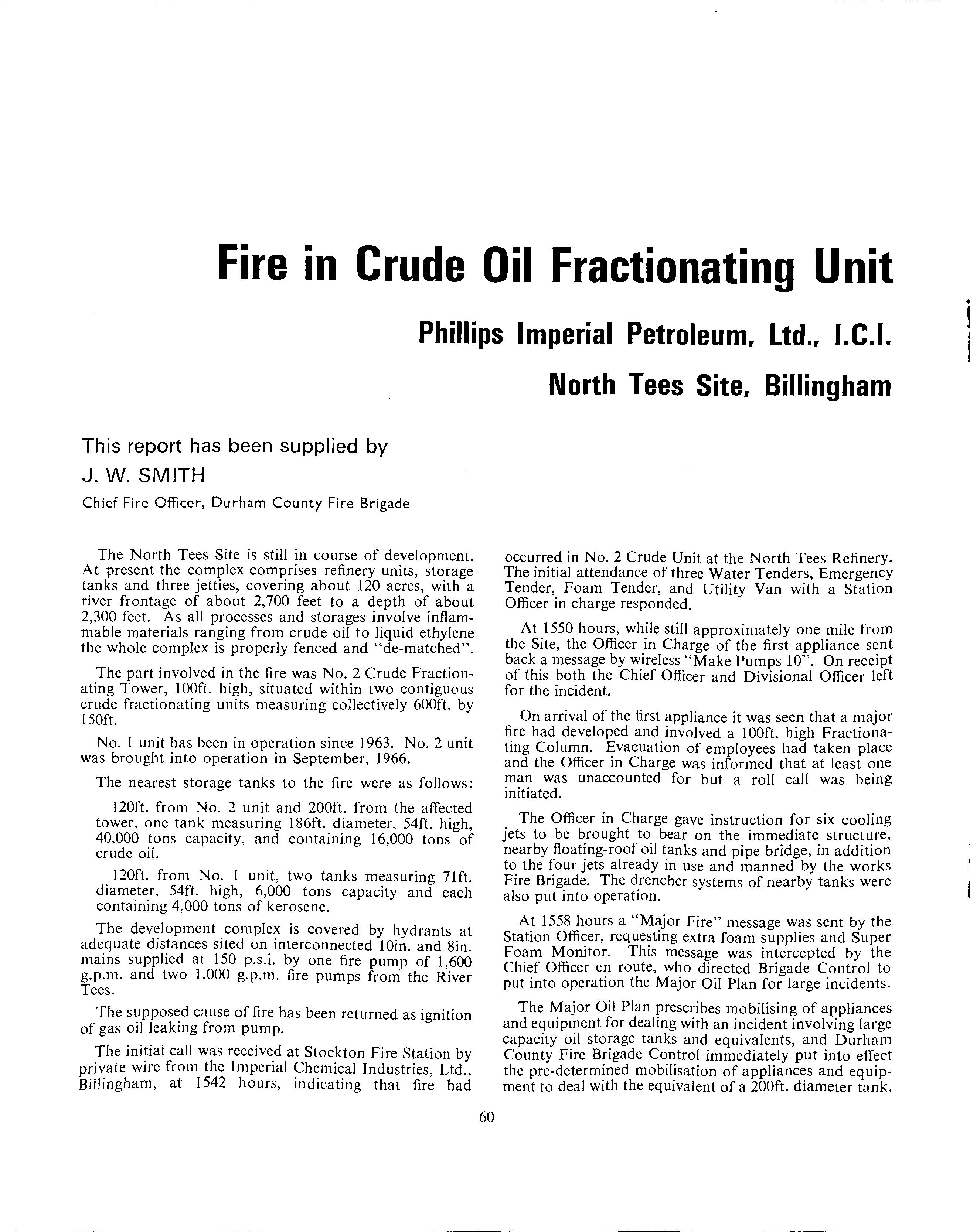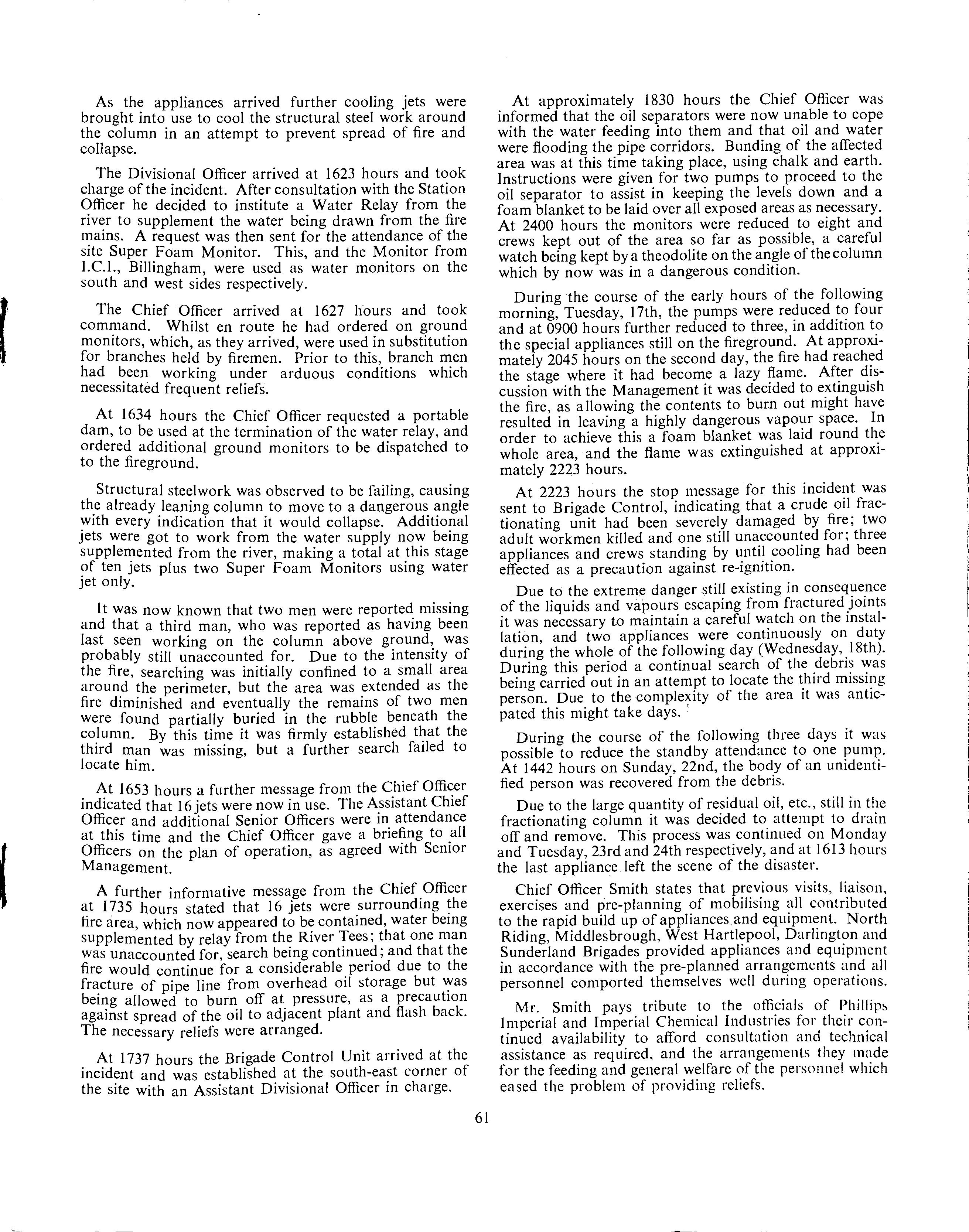
8 minute read
FIRE IN CRUDE OIL FRACTIONATING UNIT, NORTH TEES SITE-J. w. SMITH
by apeauk
Fire in Crude Oil Fractionating Unit
Phillips Imperial Petroleum, Ltd., l.C.I. North Tees Site, Billingham
Advertisement
This report has been supplied by .J. W. SMITH
Chief Fire Officer, Durham County Fire Brigade
The North Tees Site is still in course of development. At present the complex comprises refinery units, storage tanks and three jetties, covering about 120 acres, with a river frontage of about 2, 700 feet to a depth of about 2,300 feet. As all processes and storages involve inflammable materials ranging from crude oil to liquid ethylene the whole complex is properly fenced and "de-matched".
The part involved in the fire was No. 2 Crude Fractionating Tower, IOOft. high, situated within two contiguous crude fractionating units measuring collectively 600ft. by I 50ft.
No. I unit has been in operation since I 963. No. 2 unit was brought into operation in September, 1966.
The nearest storage tanks to the fire were as follows: 120ft. from No. 2 unit and 200ft. from the affected tower, one tank measuring I 86ft. diameter, 54ft. high, 40,000 tons capacity, and containing I 6,000 tons of crude oil. 120ft. from No. 1 unit, two tanks measuring 7lft. diameter, 54ft. high, 6,000 tons capacity and each containing 4,000 tons of kerosene.
The development complex is covered by hydrants at adequate distances sited on interconnected IOin. and Sin. mains supplied at 150 p.s.i. by one fire pump of 1,600 g.p.m. and two 1,000 g.p.m. fire pumps from the River Tees.
The supposed cause of fire has been returned as ignition of gas oil leaking from pump.
The initial call was received at Stockton Fire Station by private wire from the Imperial Chemical Industries, Ltd., Billingham, at 1542 hours, indicating that fire had
60 occurred in No. 2 Crude Unit at the North Tees Refinery. The initial attendance of three Water Tenders, Emergency Tender, Foam Tender, and Utility Van with a Station Officer in charge responded.
At 1550 hours, while still approximately one mile from the Site, the Officer in Charge of the first appliance sent back a message by wireless "Make Pumps 10". On receipt of this both the Chief Officer and Divisional Officer left for the incident.
On arrival of the first appliance it was seen that a major fire had developed and involved a IOOft. high Fractionating Column. Evacuation of employees had taken place and the Officer in Charge was informed that at least one man was unaccounted for but a roll call was being initiated.
The Officer in Charge gave instruction for six cooling jets to be brought to bear on the immediate structure, nearby floating-roof oil tanks and pipe bridge, in addition to the four jets already in use and manned by the works Fire Brigade. The drencher systems of nearby tanks were also put into operation.
At 1558 hours a "Major Fire" message was sent by the Station Officer, requesting extra foam supplies and Super Foam Monitor. This message was intercepted by the Chief Officer en route, who directed Brigade Control to put into operation the Major Oil Plan for large incidents.
The Major Oil Plan prescribes mobilising of appliances and equipment for dealing with an incident involving large capacity oil storage tanks and equivalents, and Durham County Fire Brigade Control immediately put into effect the pre-determined mobilisation of appliances and equipment to deal with the equivalent of a 200ft. diameter tank.

As the appliances arrived further cooling jets were brought into use to cool the structural steel work around the column in an attempt to prevent spread of fire and collapse.
The Divisional Officer arrived at 1623 hours and took charge of the incident. After consultation with the Station Officer he decided to institute a Water Relay from the river to supplement the water being drawn from the fire mains. A request was then sent for the attendance of the site Super Foam Monitor. This, and the Monitor from I.C.I., Billingham, were used as water monitors on the south and west sides respectively.
The Chief Officer arrived at 1627 hours and took command. Whilst en route he had ordered on ground monitors, which, as they arrived, were used in substitution for branches held by firemen. Prior to this, branch men had been working under arduous conditions which necessitated frequent reliefs.
At 1634 hours the Chief Officer requested a portable dam, to be used at the termination of the water relay, and ordered additional ground monitors to be dispatched to to the fireground.
Structural steelwork was observed to be failing, causing th.e already leaning column to move to a dangerous angle ~1th every indication that it would collapse. Additional Jets were got to work from the water supply now being supplemented from the river, making a total at this stage of ten jets plus two Super Foam Monitors using water jet only.
It was now known that two men were reported missing and that a third man, who was reported as having been last seen working on the column above ground, was probably still unaccounted for. Due to the intensity of the fire, searching was initially confined to a small area around the perimeter, but the area was extended as the fire diminished and eventually the remains of two men were found partially buried in the rubble beneath the co.lumn. By this time it was firmly established t~at the tlurd man was missing, but a further search failed to locate him.
At 1653 hours a further message from the Chief Officer indicated that 16 jets were now in use. The A_ssistant Chief Officer and additional Senior Officers were m attendance at this time and the Chief Officer gave a brie~ng to .all Officers on the plan of operation, as agreed with Semor Management.
A further informative message from the Chief Officer at 1735 hours stated that 16 jets were surrounding the fire area, which now appeared to be contained, water being supplemented by relay from th~ River 'fees; that one man was unaccounted for search bemg contmued; and that the fire would continue for a considerable period due to the fracture of pipe line from overhead oil storage but was being allowed to burn off at pressure, as a precaution against spread of the oil to adjacent plant and flash back. The necessary reliefs were arranged.
At 1737 hours the Brigade Control Unit arrived at the incident and was established at the south-east corner of the site with an Assistant Divisional Officer in charge.
At approximately 1830 hours the Chief Officer was informed that the oil separators were now unable to cope with the water feeding into them and that oil and water were flooding the pipe corridors. Bunding of the affected area was at this time taking place, using chalk and earth. Instructions were given for two pumps to proceed to the oil separator to assist in keeping the levels down and a foam blanket to be laid over all exposed areas as necessary. At 2400 hours the monitors were reduced to eight and crews kept out of the area so far as possible, a careful watch being kept bya theodolite on the angle of the column which by now was in a dangerous condition.
During the course of the early hours of the following morning, Tuesday, l 7th, the pumps were reduced to four and at 0900 hours further reduced to three, in addition to the special appliances still on the fireground. At approximately 2045 hours on the second day, the fire had reach~d the stage where it had become a lazy ~ame.
Af~er
~1scussion with the Management it was decided to extmgu1sh the fire, as allowing the contents to burn out might have resulted in leaving a highly dangerous vapour space. In order to achieve this a foam blanket was laid round the whole area, and the flame was extinguished at approximately 2223 hours.
At 2223 hours the stop message for this incide~1t was sent to Brigade Control, indicating that a crude 011 fractionating unit had been severely damaged by fire; two adult workmen killed and one still unaccounted for; three appliances and crews standing by until cooling had been effected as a precaution against re-ignition.
Due to the extreme danger still existing in consequence of the liquids and vapours escaping from fractured _joints it was necessary to maintain a careful watch on the mstallation, and two appliances were continuously on duty during the whole of the following day (Wednesday,_ 18th). During this period a continual search of the .debn~ 'Yas being carried out in an attempt to locate the ~hird m1ss1~1g person. Due to the complexity of the area 1t was anttcpated this might take days. '
During the course of the following three days it was possible to reduce the standby attendance to one pump. At 1442 hours on Sunday, 22nd, the body of an unidentified person was recovered from the debris.
Due to the large quantity of residual oil, etc., still in the fractionating column it was decided to attempt to drain off and remove. This process was continued on Monday and Tuesday, 23rd and 24th respectively, and at 1613 hours the last appliance left the scene of the disaster.
Chief Officer Smith states that previous visits, liaison, exercises and pre-planning of mobilising all contributed to the rapid build up of appliances and equipment. North Riding, Middlesbrough, West Hartlepool, Darlington and Sunderland Brigades provided appliances and equipment in accordance with the pre-planned arrangements and all personnel comported themselves well during operations.
Mr. Smith pays tribute to the officials of Phillips Imperial and Imperial Chemical Industries for their continued availability to afford consultation and technical assistance as required, and the arrangements they made for the feeding and general welfare of the personnel which eased the problem of providing reliefs.
61







